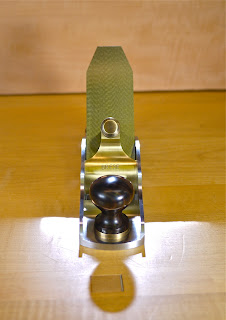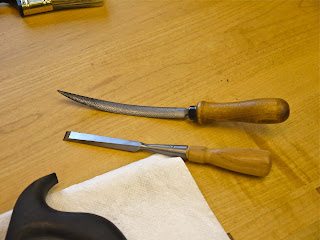Lately there has been a resurgence of interest of nailed furniture. I became interested in this idea while nailing down the wide pine floor boards during the construction of my house. I was amazed at the holding strength of square cut nails and began incorporating cut nails in furniture pieces that I made for my house.
I think most that are intrigued with this idea are still trying to define the parameters of what exactly qualifies. I've read that nailed furniture is devoid of joinery but what does this mean? Where are the dividing lines between what is considered joinery? I can't imagine one could create a good nailed piece without using glue. Does the addition of glue constitute joinery?
I guess one deciding factor is the use of fasteners, but this brings up another question. Screws. Screws are fasteners and nails are fasteners. I can't imagine the top of a cupboard on a sizable piece of furniture would stay in place long with just the use of nails for attachment, especially if there is reason to move the piece on a fairly regular basis. Even though it's not the correct way to do things, people will always look for a way to grab the top and lift up when the need arises. Then again maybe there is a solid method to attach the top of a case piece with nails that I've not come to as of yet. Certainly we'll use screws for attaching hardware but does using screws to fasten wooden parts together constitute joinery?
The piece below is nailed with square cut nails but given it's small size there's not a lot of stress on any part of this piece.
Last year I was commissioned by a local church to build a piece that would provide a place for the elements of Communion. I've not made a lot of rectory furnishings but this church is fairly unique in that the building is very craftsman in style and the details are quite simple in form. It has none of the formality that one usually associates with churches so this worked right into my interest in simpler furnishings which has been my mindset as of late. As I worked with the Pastor to develop an idea for this piece we came upon the idea of a "Communion Cupboard". I was a proponent of this idea because of some special boards that I had in my possession.
As you can see in the above picture there is a rather large sugar pine board on my workbench. I possessed 4 of these boards that were 22" wide, 1.5" thick and 8 feet long. They were quite flat and there was not a knot to be seen anywhere in these boards. Only one piece possessed a check that would have to be sawn out.
I came into these board approximately 8 years ago, and the gentleman that owned these boards before me had purchased them in 1961. I know that wide sugar pine boards can still be had today but these boards are from old growth trees and quite frankly I've never seen anything quite like them. All these years I've been waiting for a project to use these boards in their widest context and the design of the "Communion Cupboard" fit perfectly.
One of the machines left in my shop from my days as a full time commissioned furniture maker is a 25" Woodmaster planer. Obviously I would need to flatten one side of these pieces before utilizing that tool. As flat as I thought these boards were they still required a considerable amount of hand work with planes to make them flat and accurate enough for the piece I had designed.
The simpler the piece the more of a premium is placed on accuracy and proportions. This piece will have two sizable doors that will be required to lay flush in the case. In lieu of making many compromises later I have to make some very accurate piece parts in order to pull off this design.
I know I've wandered a bit in this post and you're probably wondering why a Plane maker would bother with taking on a commission of this type. It's not so much the piece as much as it is the opportunity to work these boards. Everyone that has laid their eyes these boards in person has marveled at this wood. I feel quite privileged to be the one that gets to create something from these 4 boards and given that these boards are so unique It's only fitting that they be put to use in a setting where many people will have the opportunity to enjoy them.
You may be wondering why I'm just now posting about a commission that I received a year ago. Well.....I am a Plane maker and that being the case I've had to build this piece in my "Spare" time and therefore it has taken a while.
This brings up another question, and I realize I've asked more questions than I've answered in this post, however here goes...Is there any such thing as "Spare" time?
Ron






















































